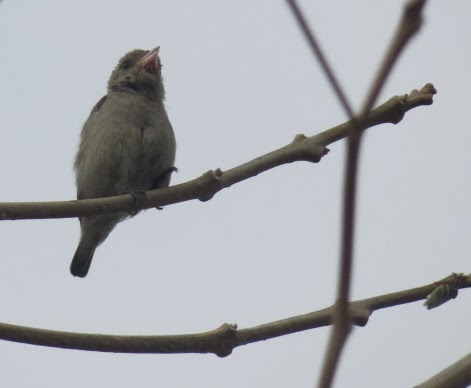PALE-BILLED FLOWERPECKER
The pictures in this post are from April or May 2013 while we were still staying in Devarachikanahlli, off Bannerghatta Road. It was a Saturday morning and I was up early in the morning to the nullah to click some birdies. After getting some nice shots and spending about two hours there, I was walking back home when I spotted two little avians on a leafless tree along the edge of a public garden. I knew that this was a chance to add another feather to my cap (See, I am showing off). I instantly ran into the garden, took up position at vantage point from where I got some decent pictures of the pair. Of course, my biggest blunder was that I did not take a single picture of the pair, preferring to concentrate on individuals. Those were early days and I was smitten by the 50X Optical Zoom of my Canon SX50HS and to be frank, the fascination still continues. Anyway, as they say there is always a next time. Last week as I was arranging the pictures in my hard disk, I came across these and on googling, I realized these were Pale-billed Flowerpeckers. I am not fully sure about the identification and please feel free to correct me.
Also known as the Tickell's Flowerpecker, this passerine bird is a resident breeder of the South India, Bangladesh, Sri Lanka and parts of Himalayas and South-East Asia. Belonging to the family Dicaeidae, the species was first described by the great British ornithologist Lotham in 1790 and is known as D. erythrorhynchos in Latin. About 8 cm in size, you can recognize this bird by its curved pinkish beak. Considering its petite size, one generally needs to rely on the rapid, sharp chirping sounds that they make in quick succession to spot them (Link). Its colors are rather dull, ranging from brown to olive green. Since its range overlaps with the Thick-billed Flowerpecker and the Niligiri Flowerpecker, there can be some confusion in identifying them. The best thing to do in this case is to observe the colors. Meanwhile, their diet generally consists of small fruits and of course, nectar from flowers. The breeding season lasts from February to June, just around the time I spotted them, reinforcing my belief that the birds I saw that was a were an 'item'. The female lays 2 to 3 eggs in a pendant-purse shaped nest.
No reference to these little beauties is complete with mentioning their astonishing relationship with epiphytic plants species like Loranthus and Viscum. The Flowerpeckers eat the berries of these plants, sucking the pulp. As they try to get rid of the seeds that have a sticky coat around them, the seeds end up on the branch of the host plant where it will germinate over the course of time. Besides, they are also important in the pollination of the flowers of the hemiparasitic Dendrophthoe falcata, commonly known as Banda Patha in Hindi. When these and several other avians species come to its dark pink flowers to get nectar, it explosively sprays pollens on the bird's plumage which helps in spreading them over distances.




No comments:
Post a Comment
Leave your comments/suggestions/views here